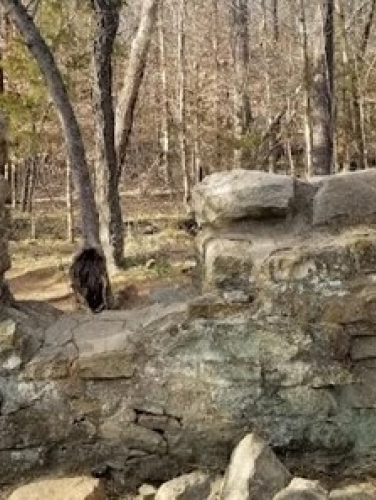
Robinson Rock House Ruin
(ca. 1780-1810)
The Robinson Rock House Ruin constitutes the final remains of a house likely constructed over 200 years ago.
9763 Plaza Rd Extension, Charlotte, NC 28215
The Robinson Rock House was built on land originally granted to Robert Robison (Robinson) by George Augustus Selwyn in 1767 and King George III in 1769. The 212-acre Selwyn tract and the 200-acre King’s grant overlapped to the extent of about one-third of each area. The site of the rock house is situated within that overlapping area. In April 1783, Robert Robison divided the combined tracts between his two sons, Robert Jr., and John. John’s portion of the land encompassed the rock house site.
Property Quick Links
It is unclear precisely when and by whom the rock house was constructed. There is an evidentiary gap in the chain of title for John Robison’s land parcel that extends from 1783 until a Matthew Wallace transferred that tract by will to his son Albert Wallace in 1854. That period of time likely includes the date of construction for the house. Later deeds for that land reference the dwelling, calling it the “Robinson Stone House,” but it has yet to be determined whether that name refers to John Robison or one of his heirs or relatives. Judging by the dates of construction of other stone houses in the area, however, the Robinson Rock House was probably built between 1780 and 1810. By the time Matthew Wallace owned it in the 1850s, the house was apparently part of a large plantation, and likely was rented to various tenants. Matthew and Albert Wallace appear to have lived in a large plantation house known as the “White House” once located about two miles southeast of the rock house.
In 1862, Albert Wallace sold the rock house as part of a 75.5-acre tract to Wesley Griffin. That property was acquired in January 1871 by George Jordan (1818-1899). Jordan and his wife Mary Eveline Notes Jordan (1821-1909) were the last residents of the rock house. According to his grandson Baxter Jordan (b. 1890), George maintained a blacksmith shop and woodworking shop near the house where he constructed a variety of products, including wagons and farm implements. Cultivation of Jordan's land, totaling 227 acres, was left to three tenant farmers. The primary crop was cotton, although food crops and livestock were also raised on the property. George, and perhaps the previous owners of the property, also prospected for gold on the land, apparently unsuccessfully.
Following George Jordan’s death, Mary moved from the rock house, bequeathing the property to the couple’s three children. The site was never occupied or cultivated again. The three children sold their respective interests in the property to former Mecklenburg County sheriff Nehemiah Wilson Wallace (1856-1925), a founder of the nearby Newell community. The house fell into ruin during Wallace’s ownership. Following Wallace’s death, the site was purchased by Beulah W. Grier, wife of Joseph W. Grier, Sr., who owned large tracts of land immediately to the west of this property. Mrs. Grier bequeathed the property to her son, Joseph W. Grier, Jr., in 1978. Less than a year later, the City of Charlotte acquired the property to be incorporated into a new park and nature preserve.

